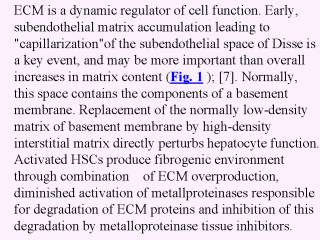 |
The latter may explain the
synthetic and metabolic dysfunction and the impaired transport of solutes from the
sinusoid to hepatocytes in advanced fibrosis and cirrhosis. ECM directly influences the
function of surrounding cells through interaction with cell surface receptors, including
integrins and nonintegrin matrix receptors (such as discoidin domain receptor 2). It can
also indirectly affect cell function via release of soluble cytokines, which in turn are
controlled by local metallopro-teinases (for details, see reviews at http://dispatch.mail-list.com/archives/hbv_research,
or http://janis7hepc.com/learning_about_liver_fibrosis.htm#Predicting). |
